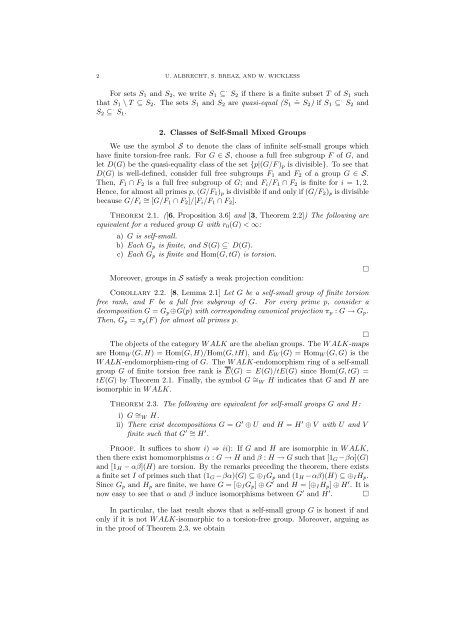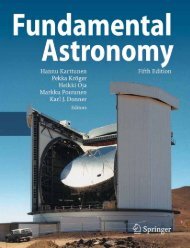Self-small Abelian Groups
Self-small Abelian Groups
Self-small Abelian Groups
You also want an ePaper? Increase the reach of your titles
YUMPU automatically turns print PDFs into web optimized ePapers that Google loves.
2 U. ALBRECHT, S. BREAZ, AND W. WICKLESS<br />
For sets S1 and S2, we write S1 ⊆ · S2 if there is a finite subset T of S1 such<br />
.<br />
that S1 \ T ⊆ S2. The sets S1 and S2 are quasi-equal (S1 = S2) if S1 ⊆ · S2 and<br />
S2 ⊆ · S1.<br />
2. Classes of <strong>Self</strong>-Small Mixed <strong>Groups</strong><br />
We use the symbol S to denote the class of infinite self-<strong>small</strong> groups which<br />
have finite torsion-free rank. For G ∈ S, choose a full free subgroup F of G, and<br />
let D(G) be the quasi-equality class of the set {p|(G/F )p is divisible}. To see that<br />
D(G) is well-defined, consider full free subgroups F1 and F2 of a group G ∈ S.<br />
Then, F1 ∩ F2 is a full free subgroup of G; and Fi/F1 ∩ F2 is finite for i = 1, 2.<br />
Hence, for almost all primes p, (G/F1)p is divisible if and only if (G/F2)p is divisible<br />
because G/Fi ∼ = [G/F1 ∩ F2]/[Fi/F1 ∩ F2].<br />
Theorem 2.1. ([6, Proposition 3.6] and [3, Theorem 2.2]) The following are<br />
equivalent for a reduced group G with r0(G) < ∞:<br />
a) G is self-<strong>small</strong>.<br />
b) Each Gp is finite, and S(G) ⊆ · D(G).<br />
c) Each Gp is finite and Hom(G, tG) is torsion.<br />
Moreover, groups in S satisfy a weak projection condition:<br />
Corollary 2.2. [8, Lemma 2.1] Let G be a self-<strong>small</strong> group of finite torsion<br />
free rank, and F be a full free subgroup of G. For every prime p, consider a<br />
decomposition G = Gp⊕G(p) with corresponding canonical projection πp : G → Gp.<br />
Then, Gp = πp(F ) for almost all primes p.<br />
<br />
The objects of the category W ALK are the abelian groups. The W ALK-maps<br />
are HomW (G, H) = Hom(G, H)/Hom(G, tH), and EW (G) = HomW (G, G) is the<br />
W ALK-endomorphism-ring of G. The W ALK-endomorphism ring of a self-<strong>small</strong><br />
group G of finite torsion free rank is E(G) = E(G)/tE(G) since Hom(G, tG) =<br />
tE(G) by Theorem 2.1. Finally, the symbol G ∼ =W H indicates that G and H are<br />
isomorphic in W ALK.<br />
Theorem 2.3. The following are equivalent for self-<strong>small</strong> groups G and H:<br />
i) G ∼ =W H.<br />
ii) There exist decompositions G = G ′ ⊕ U and H = H ′ ⊕ V with U and V<br />
finite such that G ′ ∼ = H ′ .<br />
Proof. It suffices to show i) ⇒ ii): If G and H are isomorphic in W ALK,<br />
then there exist homomorphisms α : G → H and β : H → G such that [1G −βα](G)<br />
and [1H − αβ](H) are torsion. By the remarks preceding the theorem, there exists<br />
a finite set I of primes such that (1G −βα)(G) ⊆ ⊕IGp and (1H −αβ)(H) ⊆ ⊕IHp.<br />
Since Gp and Hp are finite, we have G = [⊕IGp] ⊕ G ′ and H = [⊕IHp] ⊕ H ′ . It is<br />
now easy to see that α and β induce isomorphisms between G ′ and H ′ . <br />
In particular, the last result shows that a self-<strong>small</strong> group G is honest if and<br />
only if it is not W ALK-isomorphic to a torsion-free group. Moreover, arguing as<br />
in the proof of Theorem 2.3, we obtain
















